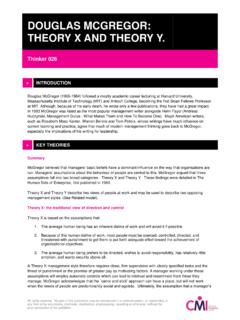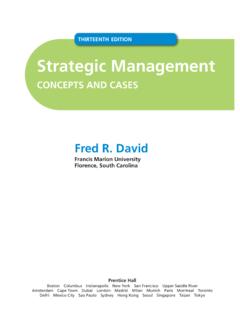Transcription of MICHAEL PORTER: WHAT IS STRATEGY?
1 All rights reserved. No part of this publication may be reproduced in a retrieval system, or transmitted, in any form or by any means, electronic, mechanical, photocopying, recording or otherwise, without the prior permission of the publisher. MICHAEL PORTER: WHAT IS STRATEGY? Thinker 028 INTRODUCTION Porter has generally been viewed as being at the leading edge of strategic thinking since his first major publication, Competitive Strategy (1980), which was a great success and became a corporate bible for many in the early 1980s. A second major publication Competitive Advantage (1985) introduced the now familiar concepts of competitive advantage and the value chain. His five forces model has been widely taught and his ideas have been hugely influential for organisations and governments on a global scale. Although he has always had his critics, Porter s reputation has taken a particularly serious dent in recent years with the bankruptcy of his strategy consulting firm Monitor and its subsequent acquisition by Deloitte; as well as robust challenges being made to some of his key ideas.
2 LIFE AND CAREER Born in 1947, Porter completed a degree in aeronautical engineering at Princeton in 1969 and took an economics doctorate at Harvard, joining the faculty there as a tenured professor at the age of 26. He has acted as consultant to companies and to governments and, like many academics, set up a consulting company, Monitor, in 1983. Porter is currently the Bishop William Lawrence University Professor at The Institute for Strategy and Competitiveness, Harvard Business School. KEY THEORIES Porter's Thinking Porter s thinking on strategy has been supported by precision research into industries and companies, and has remained consistent as well as developmental. He has concentrated on different aspects at different times, spinning the threads together with a logic that seemed irrefutable. Before Competitive Strategy, most strategic thinking focused either on the organisation of a company's internal resources and their adaptation to meet particular circumstances in the marketplace, or on increasing an organisation's competitiveness by lowering prices to increase market share.
3 These approaches, derived from the work of Igor Ansoff, were bundled into systems or processes which provided strategy with its place in the organisation. All rights reserved. No part of this publication may be reproduced in a retrieval system, or transmitted, in any form or by any means, electronic, mechanical, photocopying, recording or otherwise, without the prior permission of the publisher. In Competitive Strategy, Porter managed to reconcile these approaches, providing management with a fresh way of looking at strategy - from the point of view of industry itself rather than just from the point of view of markets, or of organisational capabilities. In Competitive Advantage, he introduced the concept of the value chain which enabled organisations to look in detail at each stage of their operations. Each unit could then be costed and measured for competitiveness.
4 The Value Chain Porter describes two different types of business activity - primary and secondary. Primary activities are principally concerned with transforming inputs (raw materials) into outputs (products), and delivery and after-sales support. These usual line management activities include Inbound Logistics (materials handling, warehousing), Operations (turning raw materials into finished products), Outbound Logistics (order processing, and distribution), Marketing and Sales (communication and pricing), and Service (installation and after-sales service). Secondary activities support the primary and include Procurement (purchasing and supply), Technology Development (know-how, procedures and skills), Human Resource Management (recruitment, promotion, appraisal, reward and development), and Firm Infrastructure (general and quality management, finance, planning).
5 To be able to survive competition and supply what customers want to buy, the firm has to ensure that all these value-chain activities link together and fit, as a weakness in any one of them will impact on the chain as a whole and affect competitiveness. The Five Forces In 1979, Porter argued that in order to examine its competitive capability in the marketplace, an organisation must choose between three generic strategies: cost leadership - becoming the lowest-cost producer in the market; differentiation - offering something different, extra or special; and focus - achieving dominance in a niche market. The question is to choose the right one at the right time. These generic strategies are driven by five competitive forces which the organisation has to take into account: the threat of new market entrants to intensify competition and further impact on pricing and profitability.
6 The threat of similar products to limit market freedom and reduce prices and thus profits the power of customers to affect pricing and reduce margins the power of suppliers to influence the organisation's pricing the level of existing competition which impacts on investment in marketing and research and thus erode profits Porter revisits his earlier work with On Competition in 1998. Here he emphasises the acceleration of market change that means companies now have to compete not just on a choice of strategic front, but on all fronts at once. Porter has also said that a company that tries to position itself in relation to the five competitive forces misunderstands his approach, since positioning is not enough. What companies have to do is ask how the five forces can help to re-write industry rules in the organisation's favour.
7 (See Related model, Porter s Five Forces). Diversification Instead of going it alone, an organisation can spread risk and attain growth by diversification and acquisition. While the blue-chip consulting companies such as Boston Consulting Group (Market growth/market share matrix) and McKinsey (7-S framework) have developed analytical models for discovering which companies will rise and fall, Porter prefers three critical tests for success: All rights reserved. No part of this publication may be reproduced in a retrieval system, or transmitted, in any form or by any means, electronic, mechanical, photocopying, recording or otherwise, without the prior permission of the publisher. 1. The attractiveness test. Industries chosen for diversification must be structurally attractive. An attractive industry will yield a high return on investment but entry barriers will be high, customers and suppliers will have only moderate bargaining power and there will be only a few substitute products.
8 An unattractive industry will be swamped by a range of alternative products, high rivalry and high fixed costs. 2. The cost-of-entry test. If the cost of entry is so high that it prejudices the potential return on investment, profitability is eroded before the game has started. 3. The better-off test. How will the acquisition provide advantage to either the acquirer or the acquired? One must offer significant advantage to the other. Porter devised seven steps to tackle these questions: 1. As competition takes place at the business unit level, identify the interrelationships among the existing business units. 2. Identify the core business which is to be the foundation of the strategy. Core businesses are those in attractive industries and where competitive advantage can be sustained. 3. Create horizontal organisational mechanisms to facilitate interrelationships among core businesses.
9 4. Pursue diversification opportunities that allow shared activities and pass all three critical tests. 5. Pursue diversification through transfer of skills if opportunities for sharing activities are limited or exhausted. 6. Pursue a strategy of restructuring if this fits the skills of management or if no good opportunities exist for forging corporate partnerships. 7. Pay dividends so that shareholders can become portfolio managers. National Competitiveness Why do some companies achieve consistent capability in innovation, seeking an ever more sophisticated source of competitive advantage? For Porter the answer lies in four attributes which affect industries: These attributes which form four points of a diamond are: Factor Conditions (the nation's skills and infrastructure to enable a competitive position), Demand Conditions (the nature of home-market demand), Related and Supporting Industries (presence or absence of supplier/feeder industries), and Firm Strategy, Structure and Rivalry (the national conditions under which companies are created, grow, organise and manage).
10 These are the chief determinants which create the environment in which firms flourish and compete. The points on the diamond constitute a self-reinforcing system, where the effect of one point often depends on the state of the others and any weaknesses at one point will impact adversely on an industry's capability to compete. The New Strategic Wave Somewhere between 1980 and 1990 strategic planning came unstuck. Old theories no longer worked as customers became more demanding and changeable, and markets and technologies rose and fell ever more rapidly. Even industries that were once distinct with definable products and services now converged and became blurred. A new wave of more subversive strategic thinking - with Gary Hamel and Strategy as Revolution, and Mintzberg with The Fall and Rise of Strategic Planning - emerged to replace the old rule-book.



